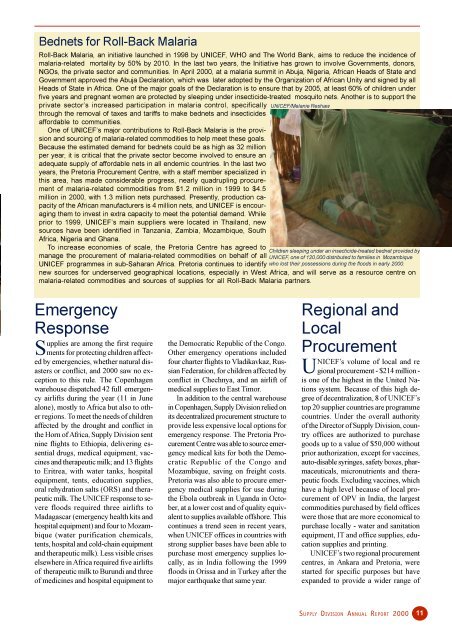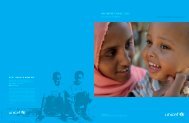Medical supplies and equipment - Unicef
Medical supplies and equipment - Unicef
Medical supplies and equipment - Unicef
You also want an ePaper? Increase the reach of your titles
YUMPU automatically turns print PDFs into web optimized ePapers that Google loves.
Bednets for Roll-Back Malaria<br />
Roll-Back Malaria, an initiative launched in 1998 by UNICEF, WHO <strong>and</strong> The World Bank, aims to reduce the incidence of<br />
malaria-related mortality by 50% by 2010. In the last two years, the Initiative has grown to involve Governments, donors,<br />
NGOs, the private sector <strong>and</strong> communities. In April 2000, at a malaria summit in Abuja, Nigeria, African Heads of State <strong>and</strong><br />
Government approved the Abuja Declaration, which was later adopted by the Organization of African Unity <strong>and</strong> signed by all<br />
Heads of State in Africa. One of the major goals of the Declaration is to ensure that by 2005, at least 60% of children under<br />
five years <strong>and</strong> pregnant women are protected by sleeping under insecticide-treated mosquito nets. Another is to support the<br />
private sector’s increased participation in malaria control, specifically<br />
through the removal of taxes <strong>and</strong> tariffs to make bednets <strong>and</strong> insecticides<br />
affordable to communities.<br />
One of UNICEF’s major contributions to Roll-Back Malaria is the provision<br />
<strong>and</strong> sourcing of malaria-related commodities to help meet these goals.<br />
Because the estimated dem<strong>and</strong> for bednets could be as high as 32 million<br />
per year, it is critical that the private sector become involved to ensure an<br />
adequate supply of affordable nets in all endemic countries. In the last two<br />
years, the Pretoria Procurement Centre, with a staff member specialized in<br />
this area, has made considerable progress, nearly quadrupling procurement<br />
of malaria-related commodities from $1.2 million in 1999 to $4.5<br />
million in 2000, with 1.3 million nets purchased. Presently, production capacity<br />
of the African manufacturers is 4 million nets, <strong>and</strong> UNICEF is encouraging<br />
them to invest in extra capacity to meet the potential dem<strong>and</strong>. While<br />
prior to 1999, UNICEF’s main suppliers were located in Thail<strong>and</strong>, new<br />
sources have been identified in Tanzania, Zambia, Mozambique, South<br />
Africa, Nigeria <strong>and</strong> Ghana.<br />
To increase economies of scale, the Pretoria Centre has agreed to<br />
manage the procurement of malaria-related commodities on behalf of all<br />
UNICEF programmes in sub-Saharan Africa. Pretoria continues to identify<br />
Emergency<br />
Response<br />
S upplies<br />
are among the first require<br />
ments for protecting children affected<br />
by emergencies, whether natural disasters<br />
or conflict, <strong>and</strong> 2000 saw no exception<br />
to this rule. The Copenhagen<br />
warehouse dispatched 42 full emergency<br />
airlifts during the year (11 in June<br />
alone), mostly to Africa but also to other<br />
regions. To meet the needs of children<br />
affected by the drought <strong>and</strong> conflict in<br />
the Horn of Africa, Supply Division sent<br />
nine flights to Ethiopia, delivering essential<br />
drugs, medical <strong>equipment</strong>, vaccines<br />
<strong>and</strong> therapeutic milk; <strong>and</strong> 13 flights<br />
to Eritrea, with water tanks, hospital<br />
<strong>equipment</strong>, tents, education <strong>supplies</strong>,<br />
oral rehydration salts (ORS) <strong>and</strong> therapeutic<br />
milk. The UNICEF response to severe<br />
floods required three airlifts to<br />
Madagascar (emergency health kits <strong>and</strong><br />
hospital <strong>equipment</strong>) <strong>and</strong> four to Mozambique<br />
(water purification chemicals,<br />
tents, hospital <strong>and</strong> cold-chain <strong>equipment</strong><br />
<strong>and</strong> therapeutic milk). Less visible crises<br />
elsewhere in Africa required five airlifts<br />
of therapeutic milk to Burundi <strong>and</strong> three<br />
of medicines <strong>and</strong> hospital <strong>equipment</strong> to<br />
the Democratic Republic of the Congo.<br />
Other emergency operations included<br />
four charter flights to Vladikavkaz, Russian<br />
Federation, for children affected by<br />
conflict in Chechnya, <strong>and</strong> an airlift of<br />
medical <strong>supplies</strong> to East Timor.<br />
In addition to the central warehouse<br />
in Copenhagen, Supply Division relied on<br />
its decentralized procurement structure to<br />
provide less expensive local options for<br />
emergency response. The Pretoria Procurement<br />
Centre was able to source emergency<br />
medical kits for both the Democratic<br />
Republic of the Congo <strong>and</strong><br />
Mozambique, saving on freight costs.<br />
Pretoria was also able to procure emergency<br />
medical <strong>supplies</strong> for use during<br />
the Ebola outbreak in Ug<strong>and</strong>a in October,<br />
at a lower cost <strong>and</strong> of quality equivalent<br />
to <strong>supplies</strong> available offshore. This<br />
continues a trend seen in recent years,<br />
when UNICEF offices in countries with<br />
strong supplier bases have been able to<br />
purchase most emergency <strong>supplies</strong> locally,<br />
as in India following the 1999<br />
floods in Orissa <strong>and</strong> in Turkey after the<br />
major earthquake that same year.<br />
UNICEF/Melanie Reshaw<br />
Children sleeping under an insecticide-treated bednet provided by<br />
UNICEF, one of 120,000 distributed to families in Mozambique<br />
who lost their possessions during the floods in early 2000.<br />
new sources for underserved geographical locations, especially in West Africa, <strong>and</strong> will serve as a resource centre on<br />
malaria-related commodities <strong>and</strong> sources of <strong>supplies</strong> for all Roll-Back Malaria partners.<br />
Regional <strong>and</strong><br />
Local<br />
Procurement<br />
U NICEF’s<br />
volume of local <strong>and</strong> re<br />
gional procurement - $214 million -<br />
is one of the highest in the United Nations<br />
system. Because of this high degree<br />
of decentralization, 8 of UNICEF’s<br />
top 20 supplier countries are programme<br />
countries. Under the overall authority<br />
of the Director of Supply Division, country<br />
offices are authorized to purchase<br />
goods up to a value of $50,000 without<br />
prior authorization, except for vaccines,<br />
auto-disable syringes, safety boxes, pharmaceuticals,<br />
micronutrients <strong>and</strong> therapeutic<br />
foods. Excluding vaccines, which<br />
have a high level because of local procurement<br />
of OPV in India, the largest<br />
commodities purchased by field offices<br />
were those that are more economical to<br />
purchase locally - water <strong>and</strong> sanitation<br />
<strong>equipment</strong>, IT <strong>and</strong> office <strong>supplies</strong>, education<br />
<strong>supplies</strong> <strong>and</strong> printing.<br />
UNICEF’s two regional procurement<br />
centres, in Ankara <strong>and</strong> Pretoria, were<br />
started for specific purposes but have<br />
exp<strong>and</strong>ed to provide a wider range of<br />
SUPPLY DIVISION ANNUAL REPORT 2000 11





